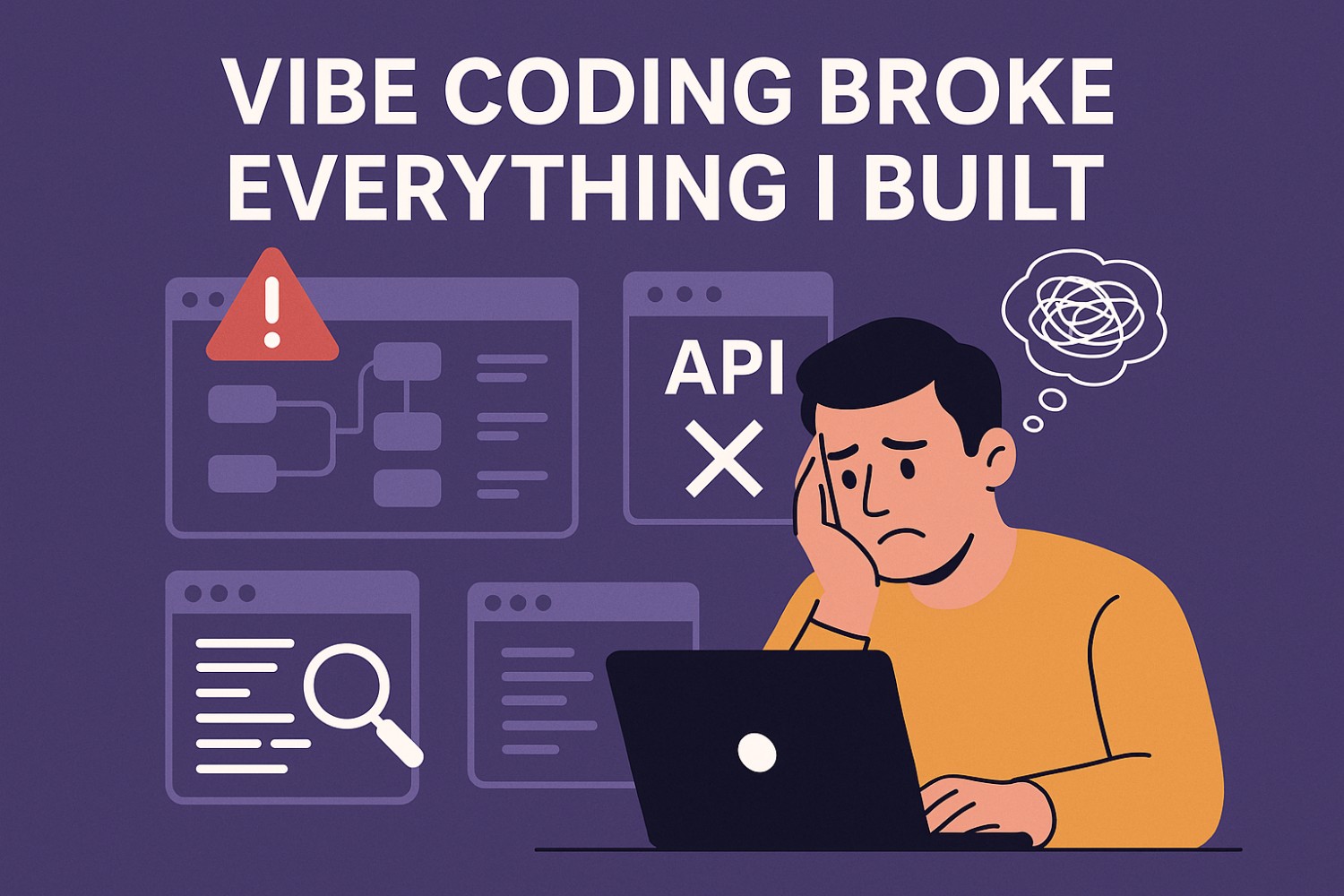"Vibe coding felt like magic — until it broke everything I built."
That’s how one of my clients described their experience after diving into the world of so-called “vibe coding” platforms. At first, it was exciting. Tools like Lovable, Bolt, and others marketed themselves as the future of software development, an intersection of AI automation, block-based interfaces, and minimal user friction. They promised rapid development, beautiful UX/UI, and the thrill of building without deep technical knowledge.
But for many, the experience didn’t live up to the hype.
In this article, I’ll unpack the rise and fall of “vibe coding” tools, why entrepreneurs and startups are pivoting back to battle-tested no-code platforms like Bubble, and why others are skipping DIY tools altogether in favor of hiring experienced developers on platforms like Hourspent.
What Is Vibe Coding?
“Vibe coding” is an emerging term in the no-code and low-code space. It refers to platforms that emphasize rapid creation using visually attractive interfaces, AI-generated logic, and pre-made components. These tools prioritize user experience and “vibes” over traditional structure and software engineering principles.
In theory, vibe coding enables:
- Drag-and-drop interfaces
- AI-assisted workflows and logic
- Instant deployment
- Minimal setup
It’s an enticing concept, especially for non-technical founders. Unfortunately, many users discover the limitations only after investing time and energy into building.
The Allure: Why Builders Tried Vibe Coding
Let’s be honest, the pitch is compelling.
You’re shown demos of people building fully-functional apps in hours. Beautiful dashboards, integrations, workflows, and even payment systems are set up with a few clicks. You think: “If they can do it, so can I.”
Clients who came to me had similar stories. They were drawn to:
- Sleek UI/UX and polished onboarding
- Promises of building AI-powered tools without writing code
- Communities buzzing with success stories
- A break from rigid logic blocks in traditional no-code tools
In short, it felt like the future.
When the Magic Fades: The Common Failures of Vibe Coding Tools
Reality quickly sets in. While the initial build process is exciting, maintaining, scaling, and shipping a real product becomes a different story.
Here’s what my clients and many others experienced:
1. Unpredictable Behavior
“Features I thought were finished would break when I wasn’t looking.”
Vibe coding platforms often depend heavily on AI-driven logic and backend auto-generation. This creates unpredictable behaviors:
- Components randomly disappear
- Workflows act differently after updates
- Saved settings revert or change unexpectedly
2. APIs That Break Overnight
APIs are the backbone of modern applications. But many vibe-based tools rely on unofficial or brittle integrations. One update on the external API can cause the whole system to fail and the platform offers no workaround or visibility.
3. Lack of Debugging Tools
You can’t fix what you can’t see.
Many vibe coding platforms abstract away traditional debugging tools in favor of simplicity. But when something goes wrong, users are left in the dark. There's no dev console, no logs, no rollback.
4. Hallucinated AI Logic
AI-generated workflows sound powerful until they start “hallucinating.” Logic that looks solid on the surface fails in real-world usage. Clients reported wasting time chasing bugs caused by AI misinterpreting their goals.
The Turning Point: “It Ain’t Flashy, But It Works”
After repeated breakdowns and growing frustration, many builders are returning to dependable platforms like Bubble, Webflow, or Wized.
“Bubble isn’t flashy, but it’s predictable, stable, and scalable.”
That was the exact quote from one client who switched back. For them, the priority became:
- Launching a stable MVP
- Minimizing babysitting and maintenance
- Building scalable infrastructure that wouldn’t collapse with every new feature
Bubble while having a steeper learning curve offers:
- Reliable backend workflows
- A robust plugin ecosystem
- A large knowledge base and community
- Version control and debugging tools
In a world where “done” is better than “perfect,” these qualities matter.
Some Gave Up No-Code Altogether And Hired Developers
Not every builder returned to no-code. Some gave up on DIY entirely and chose to hire skilled freelance developers or technical partners.
Here’s why:
- Custom Logic: They needed complex features that no-code tools couldn’t deliver reliably.
- API Integrations: Handling nuanced APIs (e.g., Stripe, AI models, or custom CRMs) required developer-level logic.
- Maintenance: They wanted professionals to manage deployments, bug tracking, and updates.
- Speed & Focus: Instead of learning tools, they focused on product strategy while developers handled the tech.
One client who tried vibe coding for six weeks told me:
“I realized I was spending 80% of my time fighting bugs and learning a new tool, and only 20% building something valuable. Once I brought in a developer, everything changed.”
Vibe Coding vs. No-Code vs. Developers: A Quick Comparison
| Feature | Vibe Coding | Traditional No-Code | Hiring Developers |
|---|---|---|---|
| Speed to prototype | ⚡⚡⚡ | ⚡⚡ | ⚡ |
| Scalability | ⚠️ | ✅ | ✅✅ |
| Debugging | ❌ | ✅ | ✅✅ |
| Cost (short-term) | Low | Medium | High |
| Maintenance | ❌ | ⚠️ | ✅ |
| Custom logic | ⚠️ | ⚠️ | ✅✅ |
| Stability | ⚠️ | ✅ | ✅✅ |
| Predictability | ❌ | ✅ | ✅✅ |
Key Lessons from the Vibe Coding Craze
1. MVPs Must Work, Not Just Look Good
An MVP isn’t just about how quickly you can build it. It’s about launching a product that delivers value and doesn’t break under pressure.
2. Tool Hype Doesn’t Replace Proven Performance
Just because a tool has slick marketing doesn’t mean it’s production-ready. A tool may trend on Product Hunt or Hacker News, but that doesn’t make it stable.
3. Founders Need to Focus on Product, Not Fighting Platforms
Your time is best spent refining your idea, talking to users, and growing your business — not debugging hallucinated AI workflows or wondering why your app is down.
4. No-Code Is Still Powerful — When Chosen Wisely
No-code isn’t dead. In fact, it’s thriving — but tools like Bubble, Glide, Outsystems, and Webflow are earning their stripes not because they’re trendy, but because they tend to deliver.
What Should You Do If You're Stuck in a Vibe Coding Trap?
Here’s a three-step plan I recommend to my clients:
1. Audit Your Current Build
- List out the critical features.
- Document what breaks often.
- Analyze how much time is lost to debugging.
2. Choose Stability Over Style
- Switch to a no-code platform with real dev support, plugin ecosystems, and transparent logic.
- Prioritize platforms that offer debugging, user authentication, API connections, and data management.
3. Consider Hiring Help
- If your vision is ambitious or time-sensitive, bring in a vetted developer.
- Use platforms like Hourspent to find vetted freelance developers with experience in Bubble, React, Flutter, or one who can build from the ground up without no-code/low-code platforms.
- Even a part-time technical partner can save you weeks of effort.
Conclusion: It’s Time to Get Serious
Vibe coding was a fun experiment. It offered a glimpse of what might be possible with AI and UX-first dev tools. But when your startup is on the line — when you have real users, paying customers, and deadlines — “vibes” aren’t enough.
That’s why founders are making the switch:
- Back to stable no-code platforms
- Or forward — by hiring skilled developers to bring their ideas to life without compromise.
If you’ve tried vibe coding and felt the sting of unreliability, you’re not alone. The good news? You don’t need to stay stuck.
Whether you go back to no-code, or decide to work with technical experts, the goal remains the same: build products that work.
Join the Conversation
Have you tried vibe coding? Did you return to traditional no-code or hire a developer? Let’s compare notes.
Share this article with others burned by vibe coding.
Drop your experience in the comments.






